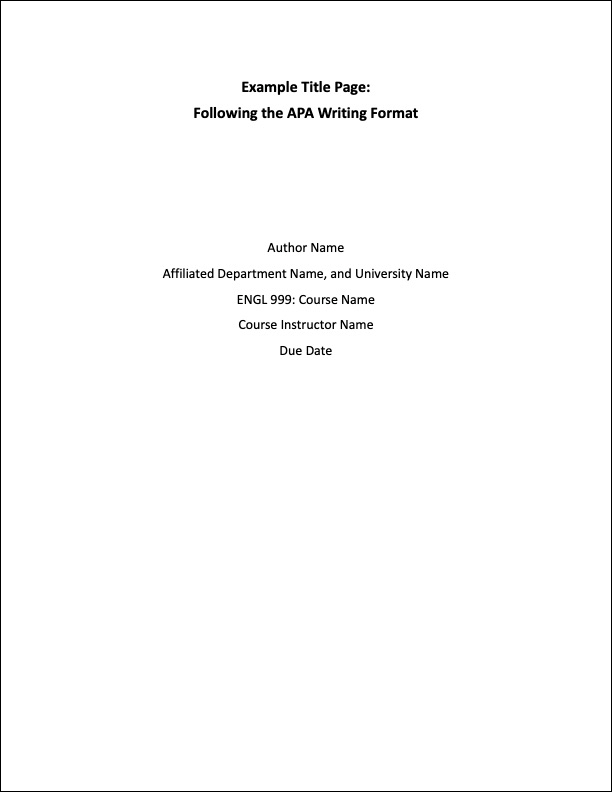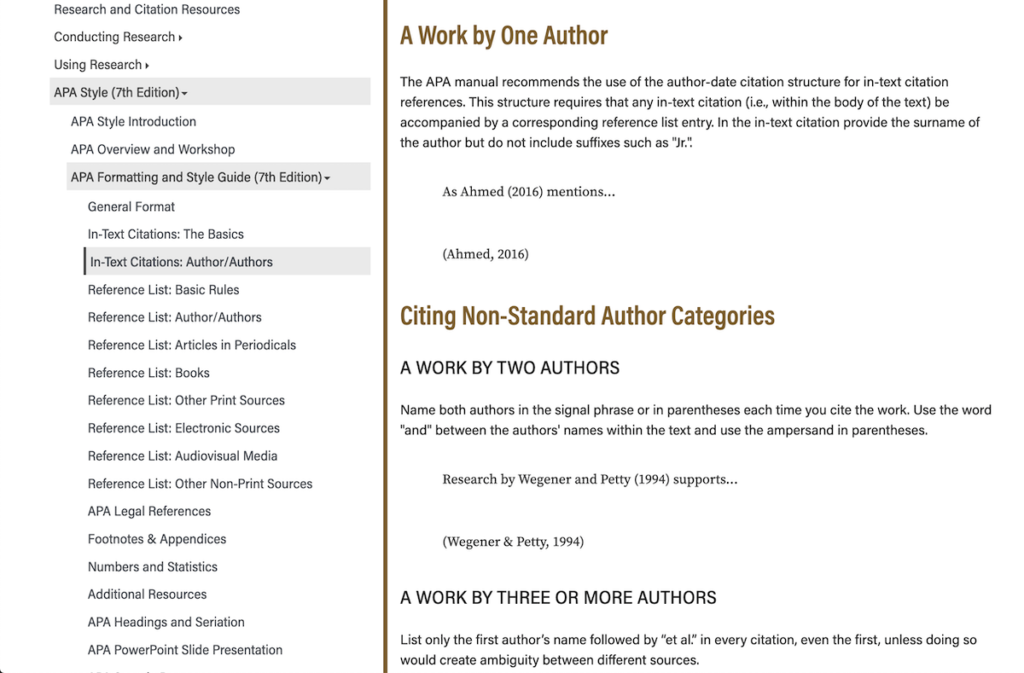The APA writing style is the official writing style of the American Psychological Association, and it is the standard in many academic disciplines. These subjects include psychology, education, and other social sciences. If you are a student in almost any of those majors, you will certainly need to know how to write an APA paper for college success.
Writing in APA format may appear to be a difficult task at first, especially for college students studying complex subject matter that they are still unfamiliar with. It’s normal for students to need help approaching the APA writing guidelines, at first, and this article will give some great tips when you need to follow the APA format.
Please note: This guide is by no means trying to rewrite the Purdue OWL or the APA’s official Publication Manual. Both provide very detailed directions and a few examples of papers in APA format. However, if you are writing a student paper and need help with APA guidelines, here are some simple rules to follow.
What is the APA Writing Format?
APA stands for the American Psychological Association, and students in college and postgraduate programs use the APA writing format. The APA standards include rules for everything from how to format paper title pages, APA citations, when to use capital letters, quotation marks, page numbers, and everything in between.
What is the APA Publication Manual?
Writing research papers is a complex process, and many students don’t learn the American Psychological Association format for writing in high school. Many students in high school and college receive instruction in Modern Language Association’s Style (MLA), and MLA differs from APA style in many ways. Both APA and MLA styles of papers use in-text citations, but the references page is different in each, and the entire document will have its own style and format. The APA Publication Manual is in its 7th Edition. APA format is an enforced standard for research papers in most social sciences, as well as the fields of nursing, business, and education.
What is the Purdue OWL?
The Purdue APA Online Writing Lab is truly the gold standard for student paper writing resources and instructional material. It is essential for students who need assistance with the APA writing format. The Publication Manual and the OWL both provide easy-to-follow guidance on correct APA formatting, appropriate citation style, and how to format a references list. These guides can be incredibly helpful for students writing various types of research papers. However, many college and graduate students who didn’t previously learn the foundations of APA style writing struggle to use these resources effectively without guidance.
Why is the APA writing format used for academic papers?
The goal of an APA style paper is to communicate information clearly, concisely, and without any confusion about what the author is communicating and from where the information is coming. An APA paper should present information in an organized way so that, in theory, any literate adult could read it and have a very full understanding of the topic- almost like an informational story. Even with the Purdue OWL and other style guides, many students simply don’t know the basics of how to write a paper, proposal, report, or other scholarly text in APA format. Many students feel overwhelmed simply trying to complete an APA format cover page and do an in-text citation.
What are the basic rules of following the APA writing format?
There are certain basic rules that apply to any sort of APA paper, including:
- Use a standard size 8.5-inch by 11-inch paper for your template.
- Format the page with a one-inch margin on all sides
- Each paragraph should begin on a new line with a half-inch indent.
- Be sure to double space and left align every line of the paper.
- Avoid all design flourishes, and use a simple and easy-to-read typeface.
- Include a title page, a byline, and a bibliography in your paper.
What should you include in APA title pages on a student paper?
The title page in APA style writing is a very specific format. It’s not a cover letter or where you put your brief summary of the paper. An APA format title page for an academic paper requires including the paper’s title, the author’s name and the institutional affiliation, the course number and course name, the instructor name, and the deadline for the project. The author’s name should be just under the title and should include first name, middle initial, and last name, in that order. Do not use professional titles like Dr., and degrees such as Ph.D. The institutional affiliation of the author should be below the author’s name to indicate where the research was conducted.

10 Tips For Writing A Student Paper That Follows The APA Style
1. Paraphrase quotes instead of directly quoting
While direct quotations are technically allowed in APA style, they are discouraged. Paraphrasing, or summarizing an author’s ideas in your own words, is the best way to discuss the evidence or outside information in the context of your paper.
An APA style paper is informative, not lyrical or artistic, and therefore the content of an idea is more important than how another author initially phrased it. As such, it is more important to rephrase an author’s ideas as clearly and contextually appropriately as possible than to quote her directly with quotation marks.
Some professors may limit or ban direct quotations, so it is important to learn how to paraphrase. Practice this skill by pretending you are explaining your topic to a fifth grader by using clear and detailed sentences that are chronologically or otherwise appropriately organized.
2. Use bias-free language
Bias-free language is when authors use descriptors that are objective and free from any judgment or negative connotation. Bias-free language, like all language, is dynamic and reflects changing social norms and understandings, but should always aim to reflect tolerance for all people and avoid discriminatory language or terminology.
Any research paper in APA format should use language that is respectful and neutral when discussing demographics such as age, sex, gender, race and ethnicity, as well as socioeconomic status. These are all important aspects of a person’s identity, and authors should always seek to avoid any prejudicial undertones.
3. Use active voice instead of passive voice
APA allows authors to use both active and passive voice. However, APA encourages the use of active voice and notes that authors tend to overuse passive voice when writing APA papers.
Active voice is when the subject performs the action on an object:
The students took a survey.
Passive voice is when the object (in this case, a survey) is followed by the verb, and the subject is the thing acted upon:
A survey was taken by the students.
Unless you are discussing something like a study design or method, it is generally best and most concise to write in the active voice.
4. Be mindful of verb tenses
APA guidelines require students to switch between verb tenses, depending on what they are discussing. Use past tense to discuss previous research, findings, and events, but use present tense to discuss implications for current and future understanding and practice, as well as ongoing events or phenomena.
5. Write clearly and unambiguously
Journal articles can be notoriously unclearly written and redundant, so an effective and concise explanation of your research will go a long way towards achieving a high grade. Avoid using pronouns unless it’s very clear about who or what you are speaking. The APA manual recommends that writers consider word choice and sentence structure, and make logical analogies in order to avoid ambiguities or sentences with multiple meanings.
How do you write clearly and concisely?
- Remove nonessential language and any repetitions.
- Use simple, concise language.
- Use active voice for the majority of sentences.
- Eliminate or condense verbose language.
6. Be detailed but avoid wordiness
Effective writers are detailed and specific but avoid redundancies and wordiness. Many students will write multiple sentences that repeat the same exact information that has already been written in another section or paragraph, and this can be avoided with careful re-reading and editing. You want to be clear, accurate, and specific, but in as few words as possible. Always look for redundancies within individual sentences as well as within or among entire paper sections. There is no quick fix for this- practice re-reading, revising, and coming back to your work with fresh eyes. Ask someone else to read your paper, as others will often catch redundancies and wordiness that we may not see ourselves.
7. Define unknown words and terms
Many professional and student papers in APA format are discussing technical concepts with specific terminology that may not be common knowledge. It is important to provide operational definitions in any research paper, especially when introducing a new term or describing a group of participants in a study. You want to make sure that readers understand exactly who or what you are speaking about!
8. Use APA format citations and reference correctly
Correctly formatted APA in-text citations and references are critical components of APA format and expository writing in general. Rule #1 of any kind of writing is to avoid plagiarism and make sure to cite all unique ideas. College students following the APA format should not use EasyBib or other APA format citation generators as they are apt to miss data and make multiple errors. Write reference entries manually by going to the Purdue OWL, finding the type of source that most closely fits the source you are using, and simply copy and paste your text’s information into their sample.

The format of a reference book varies from the formatting guidelines for a journal article. Making mistakes in your references will likely cost you points with your professor, but more importantly, plagerism will undermine your credibility altogether. Being detail-oriented here is everything.
9. Check your formatting
American Psychological Association requirements specify all aspects of the APA paper format, including the abstract page, numerical data, citing books and web pages, font style, spacing, indenting the first line of each paragraph, paper formatting, headings, paper title, and the references page.
The formatting differs slightly between student and professional papers as well, so it is critical for APA writers to double check the APA guide or Purdue OWL for exact formatting requirements. There is no shortcut. Simply taking the time and paying attention to all the details, such as whether or not you need to include a running head on the title page (you do if it’s a professional paper!) is the only way to ensure you get it right.
10. Be detail oriented
Once you have done a solid job with your actual research project and writing, it is essential to pay attention to stylistic and formatting elements. College students should check their work several times, at least one of which should be with “fresh eyes” after a break from working on it. Google Docs is the best place to make revisions and edits, either by yourself or with the help of a skilled editor or teacher. Pay close attention to details like the paper’s title page, page header, and in-text citations, and make sure the text is double spaced.
Knowing The Basics Can Help You Master The APA Writing Format
APA style may seem overwhelming at first, but it’s truly formulaic. If you are studying psychology, education, nursing, or any of the social sciences, learning correct APA formatting and style will make completing professional or student papers and literature reviews a relative breeze.
Many students complete excellent research and may be able to write about their findings informally, but lose points or even professional credibility by making APA formatting mistakes, most commonly regarding parenthetical citations and an incorrectly done reference page. This APA guide covers all the basics, but for more personalized writing assistance, reach out to The Savvy Tutor today!
